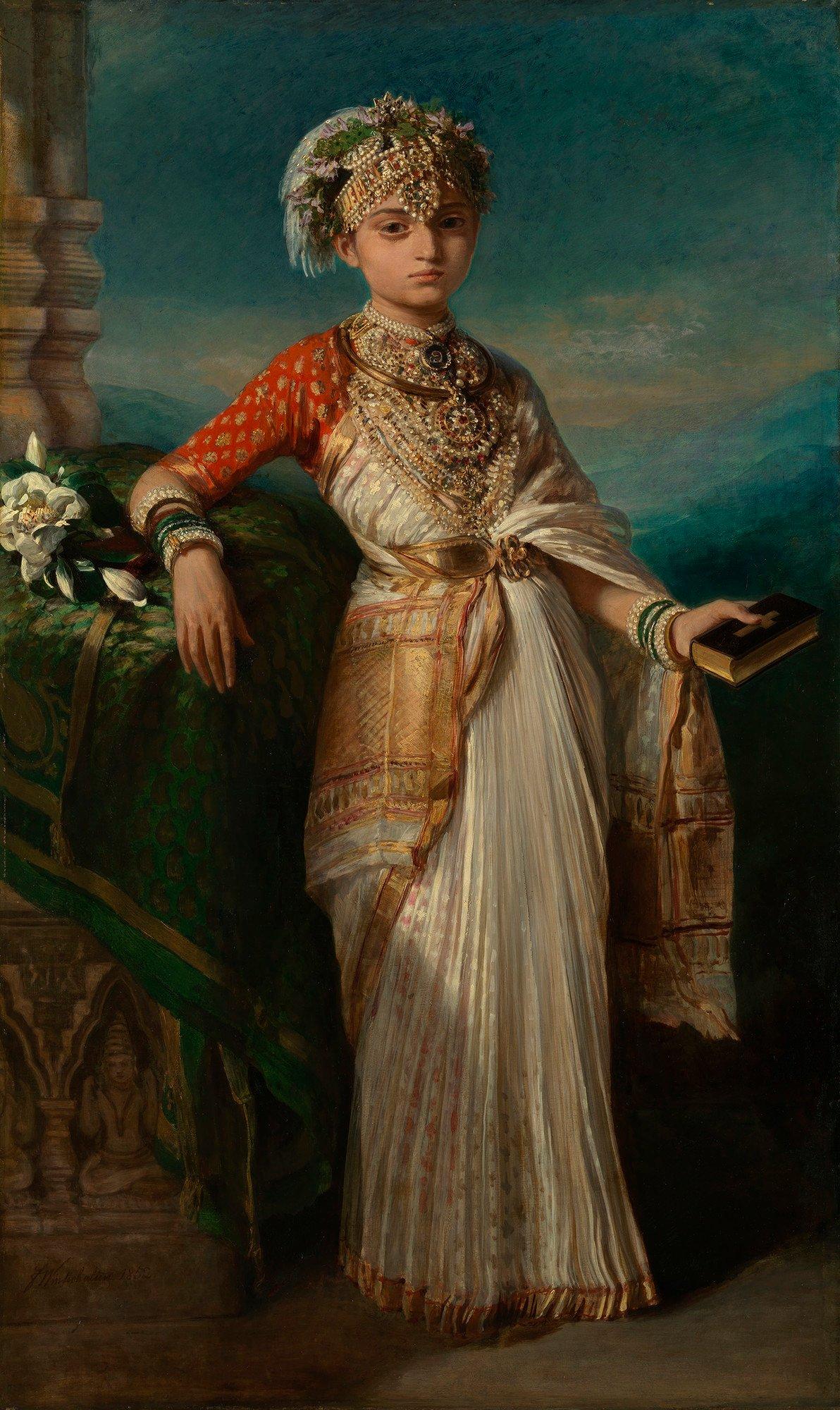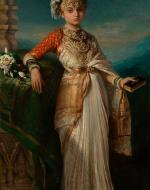Created by Mae Madrid on Fri, 10/23/2020 - 02:13
Description:
The painting showcases a portrait of Princess Victoria Gouramma which was one of the numerous royal paintings created by Franz Xaver Winterhalter in the year 1852. This portrait was created using oil on canvas, which is when the artist usually starts by sketching the subject onto the canvas with charcoal or thinned paint. This method of painting allows for pigments to be bound together to a canvas using drying oil, which is typically made of linseed or other solvents. This was a common technique he followed in many of his paintings, including his 1843 full-length portrait of Queen Victoria (Barilo von Reisberg 3). Winterhalter was well-known for following a Neoclassical style of art, which is a movement that is inspired by classical art and culture of Ancient Greece and Rome. This movement started during the 18th century Enlightenment era and through the early 19th century. Neoclassicism was represented in all types of art, including sculpture, painting, theatre, and architecture. This art style can be characterized based on the minimal use of color and simplicity of form (Palmer 2). During the 18th century, other popular art styles included Baroque, and Rococo. Artists who followed a Rococo style emphasized bright colors and ornamentation, which was considered the opposite of Neoclassicism (Palmer 2). Winterhalter’s style of art can be classified as a mixture of both art forms or being Neo-Rococo because he was known to combine a minimal use of color and represent his subjects in a straightforward and simple manner.
This was evident in his 1843 full-length portrait of Queen Victoria which showcased the queen simply standing up, but Winterhalter was still able to present the queen as a dominant figure by placing an emphasis on her throne and the palatial colonnade in the background (Barilo von Reisberg 3). He was also able to focus on details in his subjects including texture in fabrics, colors, and jewelry, which showcased his Rococo influence. Winterhalter demonstrated his Neo-Rococo influences in his 1852 portrait of Princess Victoria Gouramma as well. The painting highlights the princess, wearing a royal Indian dress, along with some fine jewelry. She is leaning against a table while holding a bible in one hand. This portrait showcased Winterhalter’s Neoclassical influences because he was able to present Princess Gouramma as the center of attention, which is similar to his previous portraits of the queen. He skillfully presented the princess with an accurate image of her identity by placing emphasis on her royal Indian background. She is presented as an elegant and wealthy young woman which is highlighted by her extravagant royal Indian dress and beautiful jewelry. Her clothes were exotic looking and did not represent the typical Victorian woman’s fashion in England, which was characterized by bonnets, top hats, corsets, and petticoats. During the Victorian era, women largely wore full skirts that moved to the back of their silhouette (Shrimpton 6-13). This difference in fashion is due to the princess’ Indian ethnicity and background.
Princess Gouramma wore a modest dress that was beautifully embroidered and what looks to be made out of material such as soft silk. Winterhalter was able to bring out the details of the princess’ dress and jewelry, which highlighted his Rococo influences. He was also able to make the princess’ figure in the painting stand out by using darker colors such as dark green and black on the background, while brighter colors such as gold, red and hints of light green were used on the princess’ dress and jewelry. The princess’ body in this portrait was also depicted realistically without distorting her waist to make it look smaller. Winterhalter was able to present the portrait of the painting naturally with none of her physical features being too dramatically emphasized. In the painting, the princess is simply standing and leaning against a table with a neutral facial expression. In the 1843 portrait of Queen Victoria, she is also simply standing with a neutral look on her face, but that painting was still able to establish her dominance because Winterhalter placed her in the center and highlighted her power as a queen by emphasizing details such as her crown in the background. Winterhalter uses this same technique with Princess Gouramma. She is placed in the center of the painting and her dominance is highlighted through her extravagant dress and jewelry, which indicate that she is of wealthy descent. In the painting, the princess is also holding a bible which could highlight her recent conversion to Christianity, which is a specific detail that could have been requested to be added in by Queen Victoria since she did want the princess to marry Duleep Singh in hopes to spread Christianity in India. Overall, Winterhalter was able to represent Princess Gouramma as a very dominant female figure in her portrait.
Works Cited:
Barilo von Reisberg, Eugene. “Garters and Petticoats: Franz Xaver Winterhalter’s 1843 Portraits of Queen Victoria and Prince Albert.” Emaj: Electronic Melbourne Art Journal, no. 5, Jan. 2010, pp. 1–
16. EBSCOhost, search.ebscohost.com/login.aspx?direct=true&db=aft&AN=505293875&site=ehost-live&scope=site.
Palmer, L. Allison. Historical Dictionary of Neoclassical Art and Architecture. Lanham, Scarecrow Press, February 11, 2011.
Shrimpton, Jayne. Victorian Fashion. London, Shire Publications, March 22, 2016.
Winterhalter, X. Franz, Princess Gouramma (1841-1864). 1852, Royal Collection Trust. https://www.rct.uk/collection/403841/princess-gouramma-1841-1864. Accessed 20 Oct. 2020


